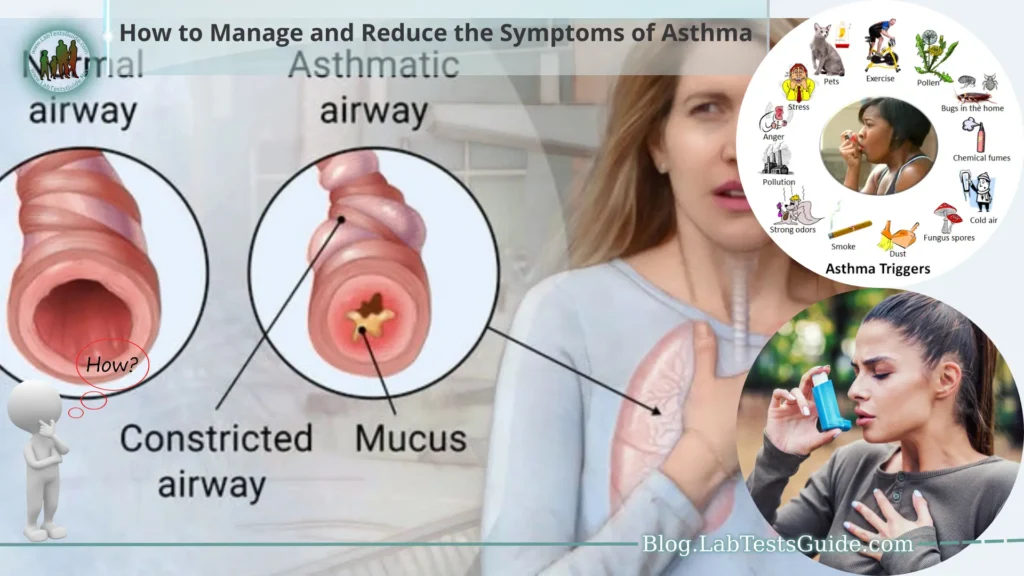Asthma is a chronic respiratory condition that affects millions of people worldwide. It is characterized by inflammation and narrowing of the airways, leading to recurrent episodes of breathlessness, wheezing, coughing, and chest tightness. While asthma cannot be cured, it can be effectively managed to reduce symptoms and improve quality of life. By understanding the triggers, adopting appropriate lifestyle changes, and following a personalized asthma action plan, individuals can gain better control over their condition and lead fulfilling lives.

This comprehensive guide aims to provide valuable insights into managing and reducing the symptoms of asthma. From understanding the nature of asthma and its various triggers to learning about medication options and lifestyle modifications, this resource will empower individuals with asthma, their families, and caregivers to make informed decisions about their health. Additionally, we will explore the role of exercise, allergy management, and mental health in asthma management, as well as offer guidance on emergency preparedness and working effectively with healthcare providers. Remember, asthma management is a collaborative effort, and with the right knowledge and support, individuals can take charge of their condition and enjoy a better quality of life.
What is Asthma?
- Asthma is a chronic respiratory condition that affects the airways in the lungs.
- It involves inflammation and swelling of the airways, making them more sensitive to various triggers.
- The condition can lead to recurrent episodes of breathlessness, wheezing, coughing, and chest tightness.
- Asthma symptoms can vary in severity and frequency from person to person.
- Common triggers of asthma include allergens (e.g., pollen, pet dander), irritants (e.g., smoke, strong odors), respiratory infections, cold air, exercise, and stress.
- During an asthma attack or exacerbation, the airways become further narrowed, leading to more severe symptoms and potential respiratory distress.
- While asthma is a chronic condition, it can be managed effectively through medications, lifestyle changes, and an asthma action plan.
- There are two main types of asthma , Allergic asthma, triggered by allergens, and non-allergic asthma, triggered by other factors.
- Asthma cannot be cured, but with proper management, most individuals can lead a normal and active life.
How to Manage and Reduce the Symptoms of Asthma:
Here are the key steps to effectively manage and reduce asthma symptoms.
Consult with a Healthcare Provider:
- Seek medical advice from a qualified healthcare provider for an accurate diagnosis and personalized asthma management plan.
- Work closely with your doctor to understand your triggers and develop an asthma action plan.
Follow the Prescribed Medication Regimen:
- Take prescribed long-term control medications regularly, even when feeling fine, to prevent asthma symptoms and reduce inflammation in the airways.
- Use quick-relief (rescue) medications as needed during asthma flare-ups or when experiencing symptoms.
Identify and Avoid Triggers:
- Determine the specific triggers that worsen your asthma symptoms and make a conscious effort to avoid them.
- Common triggers include allergens (pollen, dust mites, mold, pet dander), irritants (smoke, strong odors, air pollution), and respiratory infections.
Create an Asthma-Friendly Environment:
- Maintain good indoor air quality by keeping your living spaces clean, well-ventilated, and free from potential irritants and allergens.
- Consider using air purifiers to reduce airborne triggers.
- Practice Proper Inhaler Techniques: Learn the correct inhaler techniques and use your inhalers as prescribed to ensure that the medication reaches the airways effectively.
Monitor Peak Flow:
- Use a peak flow meter to monitor your lung function regularly and detect any changes or worsening of asthma symptoms.
- Share the peak flow measurements with your healthcare provider to adjust your asthma management plan if necessary.
Stay Physically Active:
- Engage in regular physical activities that are suitable for your asthma condition, as exercise can improve lung function and overall health.
- Always warm up before exercise and use your quick-relief inhaler before physical activity if needed.
Manage Allergies:
- If allergies trigger your asthma, work on managing them through allergen avoidance strategies or allergy medications.
- Consult with an allergist for allergy testing and consider immunotherapy if appropriate.
- Control Stress: Stress and anxiety can exacerbate asthma symptoms. Practice relaxation techniques such as deep breathing, meditation, or yoga to manage stress.
Follow Your Asthma Action Plan:
- Be familiar with your asthma action plan and follow the steps outlined in it to manage asthma flare-ups effectively.
- Know when to seek emergency medical assistance if your symptoms worsen rapidly.
Understanding Asthma:
Asthma is a chronic respiratory condition that affects the airways, the tubes that carry air in and out of the lungs. It is a complex and variable condition characterized by inflammation, narrowing, and increased sensitivity of the airways. When exposed to certain triggers, the airways become swollen and produce excess mucus, causing difficulty in breathing. Asthma symptoms can range from mild to severe and can vary over time, with periods of symptom-free intervals and episodes of exacerbation.
Key Points about Asthma:
- Common Symptoms: Typical asthma symptoms include wheezing (a high-pitched whistling sound while breathing), shortness of breath, coughing (especially at night or early in the morning), and chest tightness.
- Triggers: Asthma symptoms can be triggered by various factors, such as allergens (pollen, pet dander, dust mites), irritants (tobacco smoke, strong odors, air pollution), respiratory infections, cold air, exercise, and emotional stress.
- Types of Asthma: Asthma can be categorized into allergic asthma (triggered by allergens) and non-allergic asthma (triggered by factors other than allergens). It can also be classified based on its severity and frequency of symptoms.
- Diagnosis: An accurate asthma diagnosis involves a thorough medical history, physical examination, and lung function tests, including spirometry and peak flow measurements.
- Chronic Condition: Asthma is a chronic condition, which means it requires ongoing management to control symptoms and prevent asthma attacks.
- Asthma Action Plan: A personalized asthma action plan is crucial for managing the condition. It outlines daily medications, measures to avoid triggers, and steps to follow during an asthma attack.
- Treatment Options: Asthma can be effectively managed with medications, including long-term control medications (inhaled corticosteroids, leukotriene modifiers) and quick-relief (rescue) medications (short-acting beta-agonists). Immunotherapy may be considered for individuals with allergic asthma.
- Lifestyle Management: Making lifestyle adjustments, such as avoiding triggers, maintaining good indoor air quality, staying physically active, and managing allergies, can significantly improve asthma control.
- Regular Monitoring: Regular follow-ups with a healthcare provider are essential to monitor asthma symptoms, adjust medication if needed, and ensure the asthma action plan remains up to date.
- Emergency Preparedness: Knowing how to recognize worsening symptoms and when to seek emergency medical care is crucial in preventing severe asthma attacks.
Diagnosing Asthma:
Here are the key aspects involved in diagnosing asthma.
- Medical History: The healthcare provider will take a detailed medical history, including any family history of asthma or allergies, past respiratory illnesses, and the frequency and pattern of symptoms such as wheezing, coughing, shortness of breath, and chest tightness.
- Symptom Assessment: The patient’s reported symptoms and their relationship to potential triggers, such as exercise, allergens, or irritants, are evaluated to identify patterns consistent with asthma.
- Physical Examination: A thorough physical examination, particularly of the chest and lungs, may reveal signs such as wheezing or increased respiratory effort, which can support the suspicion of asthma.
Lung Function Tests:
- Spirometry: This is the most common lung function test used to diagnose asthma. It measures the amount of air a person can forcefully exhale after taking a deep breath (forced expiratory volume in one second – FEV1) and the total amount exhaled (forced vital capacity – FVC). These measurements help assess airway obstruction and confirm the diagnosis.
- Peak Flow Measurement: A peak flow meter is a simple handheld device used to measure how fast a person can exhale air. Regular peak flow monitoring can help identify changes in airflow and assess asthma control.
- Bronchial Provocation Tests: In cases where the diagnosis is uncertain or spirometry results are inconclusive, bronchial provocation tests may be conducted. These tests involve inhaling substances (e.g., methacholine or histamine) to provoke airway narrowing, helping to confirm asthma.
- Response to Bronchodilators: Another diagnostic test involves using a short-acting bronchodilator (e.g., albuterol) to see if it improves lung function. A significant increase in FEV1 after using the bronchodilator can indicate asthma.
- Allergy Testing: Allergy skin tests or blood tests (specific IgE) may be performed to identify allergens that could be triggering asthma symptoms, especially if allergic asthma is suspected.
- Differentiating from Other Conditions: The healthcare provider will consider other respiratory conditions that may mimic asthma symptoms, such as chronic obstructive pulmonary disease (COPD), bronchitis, or vocal cord dysfunction, to ensure an accurate diagnosis.
- Monitoring and Follow-up: Once diagnosed, regular monitoring and follow-up visits with a healthcare provider are essential to track asthma symptoms, adjust treatment as needed, and ensure the asthma management plan remains effective.
Asthma Management:
Here are the key components of asthma management.
Developing an Asthma Action Plan:
- Work with your healthcare provider to create a written asthma action plan. This plan provides guidelines on daily asthma management, steps to take during symptom flare-ups, and when to seek emergency medical care.
- Share the action plan with family members, caregivers, and school/work personnel to ensure everyone is aware of how to respond to asthma symptoms.
Medications for Asthma Control:
- Long-term control medications: These medications, such as inhaled corticosteroids, leukotriene modifiers, long-acting beta-agonists, and others, help reduce airway inflammation and prevent asthma symptoms over time. They are taken regularly, even when symptoms are not present.
- Quick-relief (rescue) medications: Short-acting beta-agonists provide rapid relief during asthma attacks or when experiencing symptoms. These medications work by relaxing the muscles around the airways and opening them up.
- Inhaler Techniques and Proper Usage: Proper inhaler technique is essential to ensure the medication reaches the lungs effectively. Learn how to use your inhaler correctly and ask your healthcare provider for guidance if needed.
- Peak Flow Monitoring: Regular peak flow monitoring with a peak flow meter can help assess lung function and detect early signs of worsening asthma. Follow your healthcare provider’s guidance on when and how to measure peak flow.
Identifying and Avoiding Triggers:
- Work to identify the specific triggers that worsen your asthma symptoms. Common triggers include allergens (e.g., pollen, pet dander), irritants (e.g., smoke, strong odors), respiratory infections, cold air, exercise, and stress.
- Take measures to avoid or minimize exposure to triggers whenever possible.
Creating an Asthma-Friendly Environment:
- Improve indoor air quality by keeping living spaces clean, well-ventilated, and free from potential irritants and allergens.
- Consider using air purifiers to reduce airborne triggers.
- Asthma and Exercise: Stay physically active as regular exercise can improve lung function and overall health.
- Consult with your healthcare provider about the best types of exercise for your asthma and use your quick-relief inhaler before physical activity if needed.
Allergy Management:
- If allergies trigger your asthma, work on managing them through allergen avoidance strategies or allergy medications.
- Consult with an allergist for allergy testing and consider immunotherapy if appropriate.
- Managing Stress: Stress and anxiety can worsen asthma symptoms. Practice relaxation techniques such as deep breathing, meditation, or yoga to manage stress effectively.
Regular Check-ups and Communication with Healthcare Providers:
- Schedule regular follow-up visits with your healthcare provider to monitor asthma control and adjust treatment as needed.
- Communicate any changes in symptoms or concerns promptly to your healthcare provider.
Lifestyle Changes to Reduce Asthma Symptoms:
Here are essential lifestyle changes to consider for reducing asthma symptoms.
Identify and Avoid Triggers:
- Work with your healthcare provider to identify specific triggers that worsen your asthma symptoms.
- Common triggers include allergens (pollen, dust mites, mold, pet dander), irritants (smoke, strong odors, air pollution), and respiratory infections.
- Once identified, take proactive measures to avoid or minimize exposure to these triggers.
Improve Indoor Air Quality:
- Keep living spaces well-ventilated and use air conditioning to reduce humidity levels, which can help control dust mites and mold growth.
- Regularly clean carpets, curtains, and bedding to reduce dust and allergens.
- Use hypoallergenic pillowcases and mattress covers to prevent dust mites from accumulating.
Create an Asthma-Friendly Environment:
- If possible, avoid exposure to tobacco smoke or any other environmental irritants that can worsen asthma symptoms.
- Choose cleaning products and household chemicals with low volatile organic compounds (VOCs) to minimize respiratory irritation.
Smoking Cessation and Secondhand Smoke Exposure:
If you smoke, quitting smoking is one of the most significant steps you can take to improve your asthma and overall health.Avoid exposure to secondhand smoke, as it can trigger asthma symptoms and worsen lung function.
- Allergen Reduction: If allergens are triggers for your asthma, implement measures to reduce exposure. For example, use allergen-proof covers for pillows and mattresses, wash bedding in hot water regularly, and vacuum with a HEPA filter.
- Irritant Avoidance: Be cautious around strong odors, fumes, and chemical irritants. Use appropriate protective gear if working with chemicals or paints.
- Maintain a Healthy Diet: Eating a balanced diet rich in fruits, vegetables, whole grains, and lean proteins can support overall health and may positively impact asthma control.
- Stay Hydrated: Adequate hydration can help keep airways moist and reduce the risk of respiratory irritation.
Regular Exercise:
Engage in regular physical activity, as exercise can improve lung function and cardiovascular health.Always warm up before exercise and use your quick-relief inhaler before physical activity if needed.
- Manage Stress: Stress and anxiety can exacerbate asthma symptoms. Practice stress-reduction techniques such as deep breathing, mindfulness, or yoga.
- Follow Your Asthma Action Plan: Adhere to the guidelines outlined in your asthma action plan to manage symptoms and respond appropriately during asthma flare-ups.
Asthma and Exercise:
Here’s how to navigate asthma and exercise.
Benefits of Exercise for Asthma:
- Regular physical activity can strengthen the respiratory muscles and improve lung function, enhancing overall cardiovascular health.
- Exercise can help control body weight, which may positively impact asthma symptoms, as obesity can worsen asthma in some individuals.
- Engaging in sports and physical activities can also have psychological benefits, reducing stress and anxiety, which can be helpful for people with asthma.
Precautions for Exercising with Asthma:
- Consult with your healthcare provider before starting any exercise program, especially if you experience asthma symptoms during or after physical activity.
- Ensure your asthma is well-controlled before engaging in vigorous exercise.
- If you have exercise-induced bronchoconstriction (EIB), your healthcare provider may recommend using a short-acting bronchodilator before exercise to prevent symptoms.
Recommended Types of Exercise:
- Most individuals with asthma can participate in a wide range of physical activities, including walking, cycling, swimming, and yoga.
- Activities that involve short bursts of intense exercise, such as sprinting or high-intensity interval training, may be more likely to trigger asthma symptoms in some individuals with EIB.
- Warm-up before exercise and cool down afterward to minimize the risk of asthma symptoms.
Proper Breathing Techniques:
- Learn and practice proper breathing techniques during exercise. Breathing through the nose and exhaling through the mouth can help reduce the risk of breathing in cold air, which may trigger symptoms.
- If you experience symptoms during exercise, try to slow down or take a break. Don’t push yourself too hard if you’re not feeling well.
Carry Your Quick-Relief Inhaler:
- Always have your quick-relief (rescue) inhaler with you during exercise in case you experience asthma symptoms.
- If you need to use your inhaler, follow your asthma action plan and consult with your healthcare provider if you find yourself using the rescue inhaler frequently during exercise.
Choose an Asthma-Friendly Environment:
- If exercising outdoors, consider choosing times when air quality is better and allergen levels are lower.
- Indoor activities, such as swimming, can be beneficial for individuals with asthma as indoor environments are often better controlled.
Allergy Management:
Here are essential strategies for allergy management.
Identify Allergens:
- Work with an allergist or healthcare provider to identify specific allergens that trigger your allergies and asthma symptoms.
- Allergy testing, including skin tests or blood tests (specific IgE), can help pinpoint the specific allergens to which you are sensitive.
Allergen Avoidance:
- Once allergens are identified, take measures to avoid or minimize exposure to them. This may include:
- Using allergen-proof covers for pillows and mattresses to reduce exposure to dust mites.
- Regularly washing bedding and curtains in hot water to kill dust mites and remove pollen.
- Keeping pets out of the bedroom or using air purifiers with HEPA filters to reduce pet dander in the air.
- Keeping windows closed during high pollen seasons or using air conditioning with HEPA filters.
- Regularly cleaning and vacuuming to reduce dust and allergen buildup.
Medication Management:
- Over-the-counter or prescription antihistamines can help alleviate allergy symptoms such as sneezing, itching, and runny nose.
- Nasal corticosteroids can help reduce nasal inflammation and congestion caused by allergies.
- Allergy shots (immunotherapy) may be recommended for individuals with significant allergic asthma. Immunotherapy involves receiving regular injections of allergen extracts to desensitize the immune system and reduce allergy symptoms over time.
Monitor Allergy Levels:
- Stay informed about pollen and mold spore counts, especially during allergy seasons. Many weather apps and websites provide this information.
- Plan outdoor activities when allergen levels are lower to reduce exposure.
Maintain a Clean and Well-Ventilated Home:
- Keep indoor spaces clean and well-ventilated to reduce allergen buildup.
- Use air purifiers with HEPA filters to trap airborne allergens.
- Consult with an Allergist: Working with an allergist or immunologist can help you develop a comprehensive allergy management plan tailored to your specific allergies and asthma triggers.
- Follow Your Asthma Action Plan: An asthma action plan should include specific guidance on managing asthma symptoms triggered by allergies. Follow the plan’s instructions for managing asthma flare-ups effectively.
Asthma Action Plan and Emergency Preparedness:
Here’s how to develop an effective Asthma Action Plan and be prepared for asthma emergencies.
Asthma Action Plan:
- Collaborate with your Healthcare Provider: Work closely with your healthcare provider, such as an asthma specialist or primary care physician, to create a personalized Asthma Action Plan based on your asthma severity, triggers, and individual needs.
Daily Management:
- The Asthma Action Plan should outline your daily asthma management, including the names and doses of your long-term control medications (e.g., inhaled corticosteroids) and when to take them.
- It may also include recommendations for peak flow monitoring and when to adjust medications based on peak flow measurements.
- Identifying and Managing Triggers: The plan should specify triggers to avoid and measures to minimize exposure to them.
- For allergic asthma, include steps to manage allergens (e.g., allergen avoidance strategies, allergy medications).
Recognizing Worsening Symptoms:
- The plan should describe early signs of worsening asthma, such as increased coughing, wheezing, shortness of breath, or decreased peak flow readings.
- Instructions on what to do if symptoms worsen should be clearly outlined.
Steps for Managing Asthma Exacerbations:
- The plan should provide detailed instructions on how to manage asthma exacerbations or attacks at home, including when to use quick-relief (rescue) medications (e.g., short-acting beta-agonists) and how to use them.
- It should also indicate when to seek emergency medical care if symptoms do not improve or worsen.
Emergency Preparedness:
- Know the Emergency Warning Signs: Learn to recognize emergency warning signs, such as severe shortness of breath, rapid breathing, difficulty speaking, retractions (pulling in of the chest wall), bluish lips or fingernails (cyanosis), and a peak flow reading in the red zone.
Act Quickly:
If you or someone with asthma experiences severe symptoms or shows emergency warning signs, take immediate action as outlined in the Asthma Action Plan.Administer quick-relief medication and seek emergency medical care if symptoms do not improve or worsen.
- Share Information: Make sure family members, friends, and caregivers are familiar with the Asthma Action Plan and know how to respond in case of an emergency.
- Carry Medications: Always have quick-relief medications, such as a rescue inhaler, readily available, even when traveling.
- Regularly Review and Update the Plan: Review your Asthma Action Plan regularly with your healthcare provider to ensure it remains relevant and effective.
- Update the plan as needed based on changes in your asthma symptoms, medication dosages, or triggers.
Working with Healthcare Providers:
Here are some key tips for working with healthcare providers.
Choose a Qualified Healthcare Provider:
- Select a healthcare provider who specializes in asthma management, such as an allergist, pulmonologist, or asthma specialist.
- Look for a provider who has experience in treating asthma and a good reputation among patients.
Open and Honest Communication:
- Be open and honest with your healthcare provider about your asthma symptoms, triggers, and any concerns or challenges you may be facing.
- Share any changes in your asthma symptoms, medication use, or lifestyle, as these can impact your asthma control
Regular Follow-Up Visits:
- Schedule regular follow-up visits with your healthcare provider as recommended to monitor your asthma control and adjust your treatment plan if needed.
- Regular visits allow your healthcare provider to track your progress, assess your lung function, and make necessary changes to optimize asthma management.
Discuss Your Asthma Action Plan:
Review your Asthma Action Plan with your healthcare provider during appointments to ensure that it is up to date and appropriate for your current asthma status. Ask any questions you may have about the plan or treatment recommendations. Before your appointment, prepare a list of questions or concerns you have about your asthma. This will help ensure that all important topics are discussed during the visit.
Understand Your Medications:
Make sure you understand how to take your medications properly, including the correct dosages and inhaler techniques. If you have any doubts about your medications, ask your healthcare provider for clarification.
- Advocate for Yourself: Be an active participant in your asthma management. Advocate for your needs and preferences, and express any concerns or issues that may impact your treatment adherence.
- Ask for Referrals: If necessary, don’t hesitate to ask your healthcare provider for referrals to other specialists or healthcare professionals who can provide additional support or services for your asthma management.
Stay Informed:
Educate yourself about asthma, its triggers, and the latest advancements in asthma management. Being informed will empower you to make educated decisions about your health and treatment options.
- Keep Records: Keep a record of your asthma symptoms, peak flow readings, and medication use. This information can be valuable during appointments and helps your healthcare provider assess your asthma control.
FAQs:
What is asthma?
Asthma is a chronic respiratory condition characterized by inflammation and narrowing of the airways, leading to recurrent episodes of breathlessness, wheezing, coughing, and chest tightness.
What causes asthma?
The exact cause of asthma is not fully understood, but it is believed to result from a combination of genetic and environmental factors. Common triggers include allergens, irritants, respiratory infections, exercise, cold air, and stress.
Can asthma be cured?
Asthma cannot be cured, but it can be effectively managed with appropriate medical treatment and lifestyle adjustments. With proper management, most individuals with asthma can lead normal and active lives.
What are the common asthma medications?
Asthma medications can be classified into two main types: long-term control medications (e.g., inhaled corticosteroids, leukotriene modifiers) used to prevent symptoms, and quick-relief (rescue) medications (e.g., short-acting beta-agonists) used during asthma attacks or when experiencing symptoms.
How is asthma diagnosed?
Asthma is diagnosed through a combination of medical history, physical examination, lung function tests (spirometry), and sometimes bronchial provocation tests or allergy testing.
Can allergies trigger asthma?
Yes, allergies can trigger asthma symptoms, especially in individuals with allergic asthma. Common allergens such as pollen, dust mites, pet dander, and mold can worsen asthma symptoms in sensitive individuals.
Can exercise trigger asthma symptoms?
Exercise can trigger asthma symptoms in some individuals, a condition known as exercise-induced bronchoconstriction (EIB) or exercise-induced asthma. However, with proper precautions and treatment, most people with asthma can participate in physical activities safely.
How can I reduce asthma symptoms?
Reducing asthma symptoms involves managing triggers, following prescribed medications, avoiding irritants, maintaining good indoor air quality, staying physically active, and managing allergies.
What should I do during an asthma attack?
During an asthma attack, follow the steps outlined in your Asthma Action Plan, which may include using a quick-relief inhaler (short-acting beta-agonist), sitting upright, and seeking emergency medical care if symptoms worsen or do not improve after using the inhaler.
Conclusion:
In conclusion, asthma is a chronic respiratory condition that requires proactive management and individualized care. While asthma cannot be cured, it can be effectively controlled through a combination of medical treatment, lifestyle adjustments, and awareness of triggers. Creating and following an Asthma Action Plan is vital for day-to-day management and early intervention during exacerbations. By working closely with qualified healthcare providers, individuals with asthma can receive the necessary support and guidance to understand their condition, recognize warning signs, and make informed decisions about treatment options. Embracing lifestyle changes, managing allergies, and staying physically active can significantly improve asthma control and overall well-being, allowing individuals to lead fulfilling lives with minimal impact from their condition. With the right approach, education, and support, individuals with asthma can achieve better asthma control and enjoy a better quality of life.






